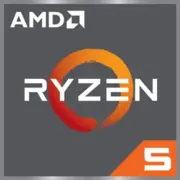AMD Ryzen 5 6600H

AMD Ryzen 5 6600H: Power and Efficiency for Versatile Laptops
March 2025
Architecture and Technology: Zen 3+ and RDNA 2 in a Compact Package
The AMD Ryzen 5 6600H processor, released under the codename Rembrandt, is built on the advanced Zen 3+ architecture and manufactured using the 6nm TSMC FinFET process. This provides a balance between performance and energy efficiency.
- 6 cores and 12 threads with a base clock speed of 3.3 GHz and a maximum turbo mode of 4.5 GHz.
- 16 MB L3 cache—twice as much as the previous generation Ryzen 5 5600H, enhancing data processing in multi-threaded tasks.
- Integrated Radeon 660M graphics based on RDNA 2 architecture with 6 compute units (384 stream processors) and a clock speed up to 1.9 GHz. This allows for gaming at 1080p resolution on low settings without a discrete graphics card.
The Zen 3+ architecture is optimized for mobile devices: improved performance with DDR5-4800/LPDDR5-6400 memory and support for PCIe 4.0 (20 lanes). This is critical for fast game loading and working with NVMe SSDs.
Power Consumption and TDP: A Fine Line Between Power and Battery Life
The Ryzen 5 6600H has a TDP of 45W, classifying it as a processor for mid-range performance laptops. However, AMD has implemented adaptive power management technologies:
- Precision Boost 2—dynamic core frequency boosts based on load and temperature.
- SmartShift—automatically reallocates power between the CPU and GPU to optimize performance.
In real-world scenarios, this means that for office tasks, the processor consumes around 10-20W, while in gaming or rendering, it can peak at 54W. A cooling system with at least two fans and copper heat pipes is required for stable operation, as seen in models like the Acer Nitro 5 or Lenovo IdeaPad Gaming 3.
Performance: A Versatile Choice for Work and Play
According to test results from Geekbench 6 (Single-Core: 1782, Multi-Core: 7257), the Ryzen 5 6600H outperforms the Intel Core i5-12450H by 12-15% in multi-threaded tasks, but falls slightly short of the Apple M2 in energy efficiency.
- Office Tasks: Running 30+ tabs in Chrome, working with Excel (spreadsheets of 100,000 rows), and video conferencing— the processor maintains responsiveness without overheating.
- Multimedia: Rendering a 10-minute video in Premiere Pro (1080p) takes about 8 minutes compared to around 12 minutes for the Ryzen 5 5600H.
- Gaming: Paired with an NVIDIA RTX 3050 Ti (laptops priced from $900), it achieves 60+ FPS in Cyberpunk 2077 (medium settings, DLSS). With integrated graphics, playable FPS (30-40) in Dota 2 and CS2.
Turbo Mode is activated when connected to a power source and under loads greater than 70%. Frequencies remain stable for the first 10-15 minutes, then decrease by 5-10% due to heating. For extended sessions, it's recommended to use cooling pads.
Use Cases: Who is the Ryzen 5 6600H Suitable For?
1. Students and Office Workers—multitasking, working with graphics in Figma, light video editing.
2. Casual Gamers—gaming at medium settings in Full HD (with a discrete GPU) or cloud gaming.
3. Freelancers—code compilation, 3D modeling in Blender, streaming.
Example: The laptop ASUS TUF Dash F15 with Ryzen 5 6600H and RTX 3050 for $999 handles rendering in Maya while simultaneously running OBS.
Battery Life: Up to 8 Hours Without a Plug
With a battery capacity of 60 Wh, the usage time varies:
- Video Playback (YouTube, 50% brightness): 6-7 hours.
- Office Tasks: 5-6 hours.
- Gaming: 1.5-2 hours.
Power-saving technologies:
- AMD PowerNow!—reducing frequencies during idle.
- Adaptive Voltage Control—dynamic voltage management.
Advice: To extend battery life, activate the "Power Saving" mode in Windows settings and limit the CPU frequency to 2.5 GHz.
Comparison with Competitors: Platform Battle
- Intel Core i5-13450H (10 cores, 16 threads): Better in single-threaded tasks (Geekbench 6 SC: 1850), but lags in multi-threaded performance (Geekbench 6 MC: 6800). Laptop prices are comparable ($900-$1100).
- Apple M2 (8 cores): Better battery life (up to 12 hours) and speed in "native" applications (Final Cut Pro), but limited compatibility with Windows software.
- AMD Ryzen 7 6800H: 15-20% more powerful in multi-threaded tasks, but more expensive ($1100+).
Conclusion: The Ryzen 5 6600H is optimal for those seeking a balance between price and performance.
Pros and Cons
Strengths:
- High multi-threaded performance.
- Powerful integrated graphics.
- Support for DDR5 and PCIe 4.0.
Weaknesses:
- Heating under load (up to 95°C at peak).
- Lack of Thunderbolt 4 (only USB4 in premium models).
Laptop Selection Recommendations
1. Device Type: Gaming laptop or versatile device with a 15.6–16 inch screen.
2. Cooling: Minimum of 2 fans + 3 heat pipes.
3. RAM: 16 GB DDR5-4800 (32 GB preferable for editing).
4. Storage: 512 GB NVMe SSD (PCIe 4.0).
5. Display: IPS panel with 120 Hz refresh rate for gaming.
Successful model example: HP Victus 16 ($950) with a 144 Hz display, 16 GB RAM, and 1 TB SSD.
Final Conclusion
The Ryzen 5 6600H is the ideal processor for those in search of a versatile laptop priced between $800 and $1200. It is suitable for:
- Gamers willing to compromise between graphics quality and FPS.
- Designers and programmers working with "heavy" applications.
- Users valuing battery life without significant sacrifices in performance.
Key advantages: future-proof architecture, support for DDR5, and impressive Radeon 660M graphics. If your budget is limited but you need power—this is the optimal choice in 2025.
Basic
CPU Specifications
Memory Specifications
GPU Specifications
Miscellaneous
Benchmarks
Compared to Other CPU
Share in social media
Or Link To Us
<a href="https://cputronic.com/en/cpu/amd-ryzen-5-6600h" target="_blank">AMD Ryzen 5 6600H</a>



